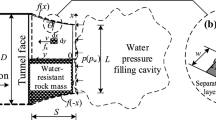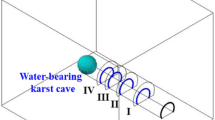Abstract
Based on the upper limit theorem of limit analysis and the Hoek-Brown failure criterion and considering the adverse influence of the seepage force, we established a stability analysis method of analyzing the water-resistant rock mass of a karst tunnel face, developed a critical safety thickness criterion for water inrush caused by the instability of the tunnel face, and conducted a sensitivity analysis of the main influencing parameters. We defined the safety coefficient (k) of the tunnel face’s resistance to water-inrush instability during the tunnel excavation process and analyzed the dynamic evolution characteristics of the tunnel face’s stability during the tunnel construction according to the safety coefficient. We used the method introduced in this paper to calculate the safe thickness of the water-resistant rock mass of the Xiema tunnel face in the first horizontal line of the Chongqing Expressway where it is adjacent to karst cavity 268. We compared these results with the calculation results of a method that did not consider the adverse influence of the karst water seepage force. The results showed that the safety thickness of the water-resistant rock mass calculated using the method proposed in this paper more accurately conformed to the actual situation of the project, which can more effectively ensure the construction safety of the tunnel segment adjacent to the anterior, concealed, high-pressure, water-rich karst cavity. The results of this study hold great significance for improving the predictability and targeted prevention of water-inrush disasters in karst tunnels.












Similar content being viewed by others
References
Chen WF (2013) Limit analysis and soil plasticity. Elsevier, Netherland
China Railway Eryuan Engineering Group CO. LTD (1984) Karst engineering geology. China Railway Press, Beijing (in Chinese)
Fraldi M, Guarracino F (2009) Limit analysis of collapse mechanisms in cavities and tunnels according to the Hoek-Brown failure criterion. Int J Rock Mech Min 46(4):665–673
Gan KR, Yang Y, Li JS (2007) Analysis on karst water inflow mechanisms and determination of thickness of safe rock walls: case study on a tunnel. Tunn Constn 27(3): 13–16, 50 (in Chinese)
Guo JQ, Li HF, Chen F, He ZY (2017) Theoretical analysis on water-resisting thickness of karst tunnel face. Chin J Underground Space Eng 13(5):1373–1380 (in Chinese)
Guo JQ, Qian Y, Chen JX, Chen F (2019) The minimum safe thickness and catastrophe process for water inrush of a karst tunnel face with multi fractures. Processes 7:686
Guo JQ, Qiao CS (2012) Study on water-inrush mechanism and safe thickness of rock wall of karst tunnel face. J China Railw Soc 34(3):106–111 (in Chinese)
Hoek E, Brown ET (1997) Practical estimates of rock mass strength. Int J Rock Mech Min 34(8):1165–1186
Hoek E, Brown ET (1980a) Underground excavations in rock. Institute of Miningand Metallurgy, London
Hoek E, Brown ET (1980b) Empirical strength criterion for rock masses. J Geotech Geoenviron 106(GT9):1013–1035
Huang F, Zhao LH, Ling TH, Yang XL (2017) Rock mass collapse mechanism of concealed karst cave beneath deep tunnel. Int J Rock Mech Min 91:133–138
Huang SW (2018) Analysis method of tunnel inrush disaster. Science Press, Beijing (in Chinese)
Huang X, Li SC, Xu ZH, Gao M, Shi XS, Gao B, Zhang B, Liu L (2019) An attribute recognition model for safe thickness assessment between concealed karst cave and tunnel. J Cent South Univ 26(4):955–969
Jiang HM, Li L, Rong XL, Wang MY, Xia YP, Zhang ZC (2017) Model test to investigate water proof-resistant slab minimum safety thickness for water inrush geohazards. Tunn Undergr Sp Tech 62:35–42
Lee IN, Nam SW (2001) The study of seepage forces acting on the tunnel lining and tunnel face in shallow tunnels. Tunn Undergr Sp Tech 16:31–40
Li LP, Li SC, Zhang QS (2010) Study of mechanism of water inrush induced by hydraulic fracturing in karst tunnels. Rock Soil Mech 31(2):523–528 (in Chinese)
Li SC, Wu J, Xu ZH, Zhou L, Zhang B (2017) A possible prediction method to determine the top concealed karst cave based on displacement monitoring during tunnel construction. B Eng Geol Environ 78:341–355
Li SC, Gao CL, Zhou ZQ, Li LP, Wang MX, Yuan YC, Wang J (2019) Analysis on the precursor information of water inrush in karst tunnels: a true triaxial model test study. Rock Mech Rock Eng 52:373–384
Li TZ, Yang XL (2018) Reliability analysis of tunnel face in broken soft rocks using improved response surface method. Int J Geomech 18(5):04018021
Li LP, Shang CS, Chu KW, Zhou ZQ, Song SG, Liu ZH, Chen YH (2021) Large-scale geo-mechanical model tests for stability assessment of super-large cross-section tunnel. Tunn Undergr Sp Tech 109:103756
Lyu C, Yu L, Wang MN, Xia PX, Sun Y (2020) Upper bound analysis of collapse failure of deep tunnel under karst cave considering seismic force. Soil Dyn Earthq Eng 132:106003
Peng J, Liu XY (2015) Water-Inrush mechanism during construction and determination of safety distance from the water source in a karst tunnel. Electron J Geotech Eng 20(8):2345–2354
Sun M, Liu WN (2011) Research on water inrush mechanism induced by karst tunnel face with high risk. Rock Soil Mech 32(4):1175–1180 (in Chinese)
Sun SQ, He P, Wang G, Li WT, Wang HB, Chen DY, Xu F (2021) Shape characterization methods of irregular cavity using Fourier analysis in tunnel. Math Comput Simulat 187:191–214
Wang H (2018) Study on the stability of surrounding rock safety thickness for the water-filling cast cave in front of the tunnel, Shandong University (in Chinese)
Wang MS (2004) Hydrologic and geological forecast of tunnel construction in the karst district. Railw Inv Survey (1): 7–9, 18 (in Chinese)
Xu ZH, Huang X, Li SC, Lin P, Shi XS, Wu J (2020) A new slice-based method for calculating the minimum safe thickness for a filled-type karst cave. B Eng Geol Environ 79:1097–1111
Yang XL, Long ZX (2015) Roof collapse of shallow tunnels with limit analysis method. J Cent South Univ 22:1926–1936
Yang ZH, Zhang JH (2016) Minimum safe thickness of rock plug in karst tunnel according to upper bound theorem. J Cent South Univ 23:2346–2353
Yang XL, Li ZW, Liu ZA, Xiao HB (2017a) Collapse analysis of tunnel floor in karst area based on Hoek-Brown rock media. J Cent South Univ 24:957–966
Yang ZH, Zhang R, Xu JS, Yang XL (2017b) Energy analysis of rock plug thickness in karst tunnels based on non-associated flow rule and nonlinear failure criterion. J Cent South Univ 24:2940–2950
Yang WM, Wang MX, Zhou ZQ, Li LP, Yuan YC, Gao CL (2019) A true triaxial geomechanical model test apparatus for studying the precursory information of water inrush from impermeable rock mass failure. Tunn Undergr Sp Tech 93:103078
Zhou ZQ, Li ZH, Gao CL, Zhang DS, Wang MX, Wei CC, Bai SS (2021) Peridynamic micro-elastoplastic constitutive model and its application in the failure analysis of rock masses. Comput Geotech 132:104037
Funding
This study was financially supported by the National Natural Science Foundation of China (Grant Nos. 51778215, U1810203), the National Key Basic Research and Development Plan (973 Plan) Project (Grant No. 2013CB036003), the China Postdoctoral Science Foundation Fund (Grant No. 2018M631114), and the Key Scientific and Technological Project of Henan Province, China (Grant No. 212102310292).
Author information
Authors and Affiliations
Corresponding author
Ethics declarations
Conflict of interest
The authors declare no competing interests.
Rights and permissions
About this article
Cite this article
Wu, W., Liu, X., Guo, J. et al. Upper limit analysis of stability of the water-resistant rock mass of a Karst tunnel face considering the seepage force. Bull Eng Geol Environ 80, 5813–5830 (2021). https://doi.org/10.1007/s10064-021-02283-6
Received:
Accepted:
Published:
Issue Date:
DOI: https://doi.org/10.1007/s10064-021-02283-6




